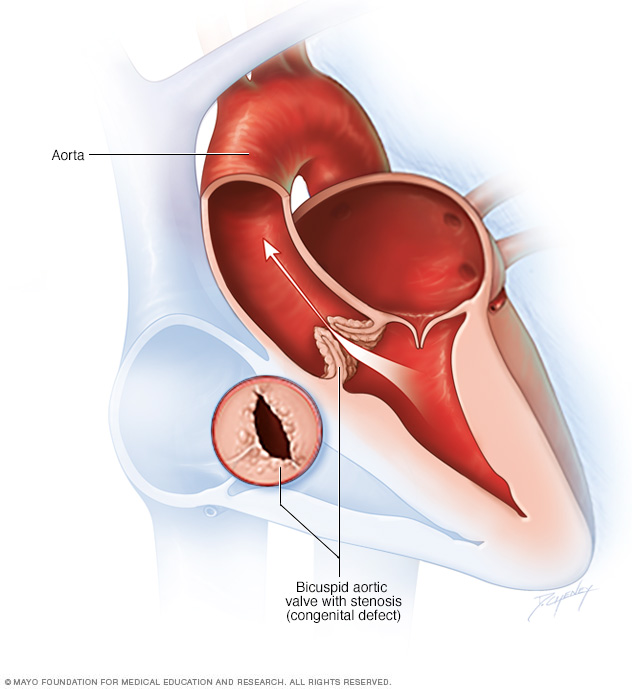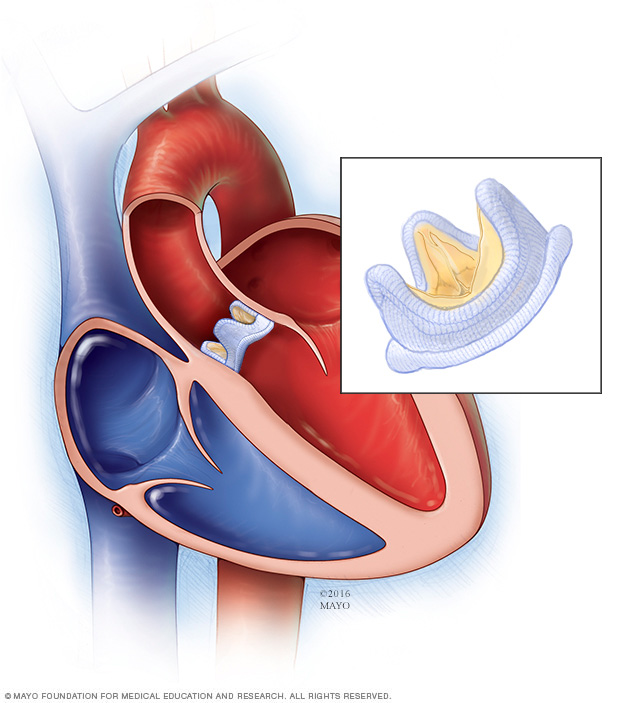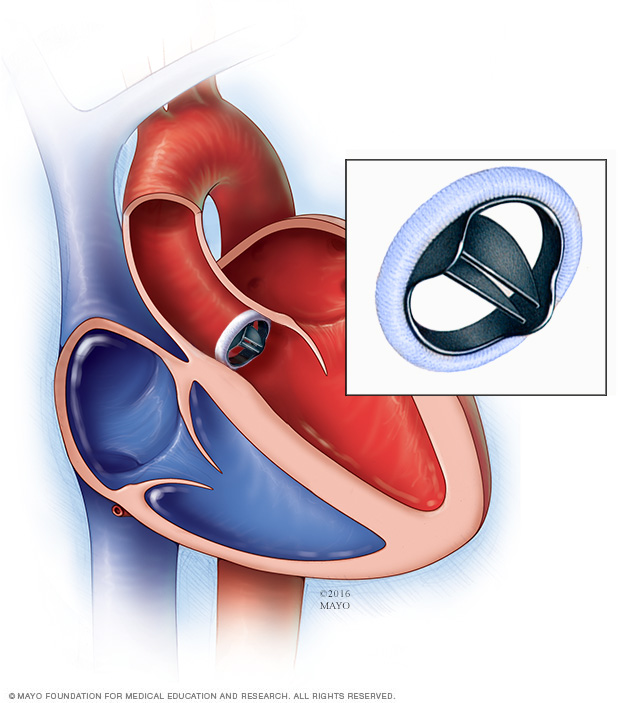Bicuspid aortic valve is a type of heart disease that you're born with (congenital heart disease).
The aortic valve separates the left lower heart chamber (left ventricle) and the body's main artery (aorta). Flaps of tissue (cusps) on the valve open and close with each heartbeat and make sure blood flows in the right direction.
Usually the aortic valve has three cusps. A bicuspid valve has only two cusps. Rarely, some people are born with an aortic valve that has one cusp (unicuspid) or four cusps (quadricuspid).
A bicuspid aortic valve may cause heart problems, including:
- Narrowing of the aortic valve (aortic valve stenosis). As a result, the valve may not open fully. Blood flow from the heart to the body is reduced or blocked.
- Backward flow of blood (aortic valve regurgitation). Sometimes, the bicuspid aortic valve doesn't close tightly, causing blood to flow backward.
- Enlarged aorta (aortopathy). Some people who have a bicuspid aortic valve have an enlarged aorta. An enlarged aorta increases the risk of a tear in the lining of the aorta (aortic dissection).

A bicuspid aortic valve is an aortic valve that has two flaps (cusps) instead of three. It may cause a narrowed or obstructed aortic valve opening (aortic valve stenosis), making it difficult for the heart to pump blood into the body's main artery (aorta).
Symptoms
Most people with a bicuspid aortic valve don't have signs or symptoms of valve disease until they're adults. However, severe symptoms may occur in infants. Symptoms of a bicuspid aortic valve include chest pain, shortness of breath and difficulty exercising.
Diagnosis
A bicuspid aortic valve may be discovered when you're having medical tests for another health condition. Your doctor may hear a heart murmur when listening to your heart with a stethoscope.
An echocardiogram is done to confirm a diagnosis of a bicuspid aortic valve. An echocardiogram uses sound waves to create video images of your heart in motion. It can show your doctor the aortic valve, the aorta, the heart chambers and the blood flow through your heart.
If you have a bicuspid aortic valve, a computed tomography (CT) scan is usually done to check for an enlarged aorta.
Treatment
If you have a bicuspid aortic valve, you will likely be referred to a doctor who specializes in congenital heart disease (congenital cardiologist).
Children and adults with a bicuspid aortic valve need regular doctor's checkups and echocardiograms to check for leaking (regurgitation) or stiffening (stenosis) of the valve or an enlarged aorta.
Treatment depends on the extent of heart valve disease. There are no medications to treat a bicuspid heart valve. However, your doctor may prescribe drugs to treat related heart problems such as high blood pressure. You may need surgery for aortic valve stenosis, aortic valve regurgitation or an enlarged aorta.
Surgeries or other procedures
Surgery may be needed to repair or replace the aortic valve. The type of surgery done depends on your specific condition and symptoms.
-
Aortic valve replacement. The surgeon removes the damaged valve and replaces it with a mechanical valve or a valve made from cow, pig or human heart tissue (biological tissue valve). Another type of biological tissue valve replacement that uses your own pulmonary valve is sometimes possible.
Biological tissue valves break down over time and may eventually need to be replaced. People with mechanical valves will need to take blood thinners for the rest of their lives to prevent blood clots. Your doctor will discuss with you the benefits and risks of each type of valve and discuss which valve may be appropriate for you.
- Aortic root and ascending aorta surgery. Surgeons remove the enlarged section of the aorta located near the heart. It's replaced with a synthetic tube (graft), which is sewn into place. Sometimes, only the enlarged section of the aorta is removed and the aortic valve remains. The aortic valve can also be replaced or repaired during this procedure.
- Balloon valvoplasty. Your doctor may recommend this procedure if a bicuspid valve caused aortic stenosis. The doctor inserts a catheter with a balloon on the tip into an artery in your groin and guides it to the aortic valve. The balloon is inflated, which expands the opening of the valve. The air is then let out of the balloon (deflated). The catheter and balloon are removed. The valve tends to narrow again in adults who have the procedure.
Lifelong care
After a bicuspid aortic valve has been diagnosed, you'll need lifelong doctor's checkups by a cardiologist to monitor for any changes in your condition.
If you have a bicuspid aortic valve, you are more likely to develop an infection of the lining of the heart (infective endocarditis). Proper dental care can help lower your risk.
A bicuspid aortic valve can be passed down in families (inherited). Because of this, doctors often recommend that parents, children and siblings (first-degree relatives) of people with a bicuspid aortic valve be screened with an echocardiogram.

In a biological valve replacement, a biological or tissue valve replaces the damaged valve.

In a mechanical valve replacement, a mechanical valve replaces the damaged valve.
Copyright © 1998-2025 Mayo Foundation for Medical Education and Research (MFMER). All rights reserved.